A solid understanding of place value will, among other things, allow your children to progress with addition and subtraction and with multiplication and division operations. Working with and handling base ten blocks (ask at school for recommendations) will provide a good foundation for this understanding.
Ones, Tens, Hundreds, & Thousands
These ten digits can make any number:
- 2-Digit Numbers: Tens & Ones
- 3-Digit Numbers: Hundreds, Tens, & Ones
- 4-Digit Numbers: Thousands, Hundreds, Tens & Ones
These printable place value arrow cards will help show how place value is used to compose numbers.
2-Digit Numbers – Tens and Ones
To make larger numbers we use a number system that has place values. The number 64 has 4 in the ones place and 6 in the tens place.
Explore different numbers with your children. Discuss how many tens and how many ones (units) there are in each number. You can use a hundred chart and, for example, note that in the shaded column below, all the numbers have 4 ones and, that in the shaded row, all the numbers have 6 tens.
| 0 | 1 | 2 | 3 | 4 | 5 | 6 | 7 | 8 | 9 |
| 10 | 11 | 12 | 13 | 14 | 15 | 16 | 17 | 18 | 19 |
| 20 | 21 | 22 | 23 | 24 | 25 | 26 | 27 | 28 | 29 |
| 30 | 31 | 32 | 33 | 34 | 35 | 36 | 37 | 38 | 39 |
| 40 | 41 | 42 | 43 | 44 | 45 | 46 | 47 | 48 | 49 |
| 50 | 51 | 52 | 53 | 54 | 55 | 56 | 57 | 58 | 59 |
| 60 | 61 | 62 | 63 | 64 | 65 | 66 | 67 | 68 | 69 |
| 70 | 71 | 72 | 73 | 74 | 75 | 76 | 77 | 78 | 79 |
| 80 | 81 | 82 | 83 | 84 | 85 | 86 | 87 | 88 | 89 |
| 90 | 91 | 92 | 93 | 94 | 95 | 96 | 97 | 98 | 99 |
If your child needs more help with place value then consider buying linking cubes or something similar to help model numbers.
Here are some more numbers shown with digits and with blocks.
Showing numbers on a number line helps develop an understanding of place value. It will help your children appreciate where numbers are positioned relative to other numbers. You will find lots of number lines here.
Use these two place value charts to help your child practice with place values.
- Place Value Chart #1 – Highlight the blocks to match the number shown on the right-hand side.
- Place Value Chart #2 – Write the value of the tens and the ones to make the number shown on the right.
Hint: Uncheck the “Show Numbers” box to print charts onto which you can write any number you like.
Try this worksheet to practice with place value.
3-Digit Numbers – Hundreds, Tens, and Ones
We’ll use this 
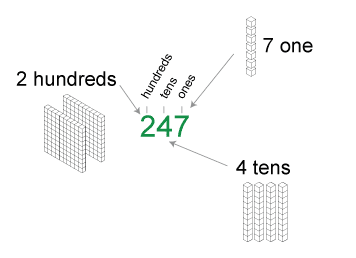
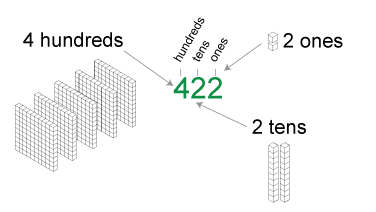
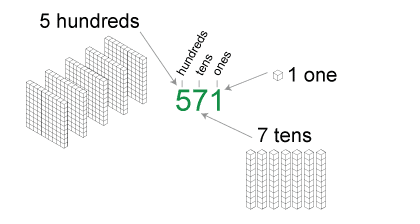
Watch where the 0 goes
Look at the numbers 206 and 260 below. It is very important to use 0 when there are no ones or tens or hundreds. The place where the 0 goes makes a big difference.
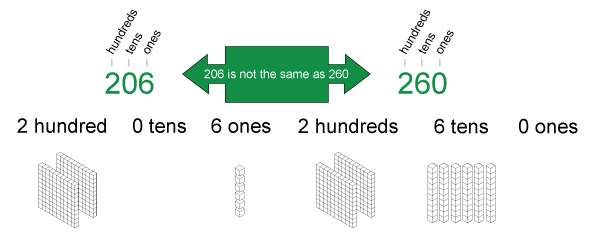
Discuss with your children the important role zero plays in our place value system. For example, with the number 206, the zero acts as a place holder; it shows the position of the tens’ place and makes it clear where the hundreds position is. Similarly, with the numbers 500 and 5000, emphasize that the zeros show the position of the 5. Avoid stating that the numbers ending in 00 are hundreds or ending in 000 are thousands. Instead discuss how the 5 is in the hundreds or thousands place. This a subtle point but helps develop a full understanding of place value.
You don’t need to include the zeros at the left of the number.
We think 0 hundreds, 5 tens, and 8 ones.
We write 58.
We say fifty-eight.
Try these two charts to help your child practice with place values with numbers to 999.
- Place Value Chart #3 – Highlight the hundreds, tens, and ones blocks to match the number shown on the right-hand side.
- Place Value Chart #4 – Write the value of the hundreds, tens and the ones to make the number shown on the right.
Hint: Uncheck the “Show Numbers” box to print charts onto which you can write any number you like.
Try this worksheet to practice with place value.
4-Digit Numbers: Thousands, Hundreds, Tens, & Ones
We can use this 
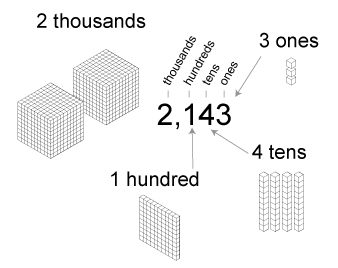
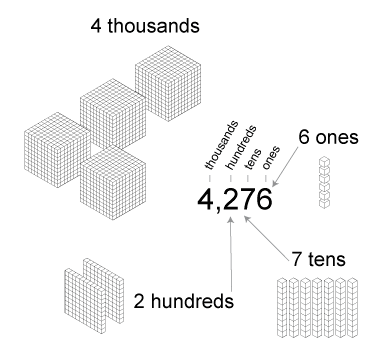
This place value chart showing thousands can be used to help your child practice with place values for numbers up to 9,999. Uncheck the “Show Numbers” box to give blank charts that can be marked up with any combination of number.
Try this place value worksheet to practice working with numbers up to 9,999.
Decimals – Tenths, Hundredths, and Thousandths
Your children should already be familiar with place value and understand that the value of a place is ten times as much as the value of the place to its immediate left. By 5th grade they should also have been introduced to decimal fractions with tenths and hundredths.
The concept of place value is further developed in 5th Grade with the introduction of thousandths. This requires the understanding that the value of a place is one tenth of the value of place to its left.
Tens Times as Much – Multiplying by 10
A good way to help develop this understanding is to first look at a place value chart, starting from the tenths place, and see how multiplying by 10 gives 10 tenths which are exchanged/ regrouped as 1 one (1 unit) which, when multiplied by 10 gives 10 ones which are exchanged/ regrouped as 1 ten. This continues across the chart as shown below.
Tens Times Less – Dividing by 10
If we move from left to right on a place value chart we can see how exchanging/ regrouping 1 million for 10 hundred thousands and then dividing by 10 gives 1 hundred thousand which can be exchanged for 10 ten thousands which, when divided by 10 gives 1 ten thousand. We can continue across the place value chart to the 1 hundredth which can be exchanged for 10 thousandths which when divided by 10 gives one thousandth.
Base-10 Blocks to Show Decimals
This may the first time your children have heard of thousandths and the use of Base-10 blocks can be an informative way to represent thousandths (and tenths and hundredths). This is done by using a block to represent one whole unit, a flat to represent one tenth, a long to represent one hundredth, and a unit to represent one thousandth as shown below.
When using Base-10 blocks to show decimal fractions, stress the difference between their previous use to show thousands, hundreds, tens, and ones.
Be careful when discussing tenths, hundredths, and thousandths with your children. Pronounce these terms with special emphasis on the “-ths” to help avoid their confusion with tens, hundreds, and thousands.
You will find more here on tenths, hundredths, and thousandths.
